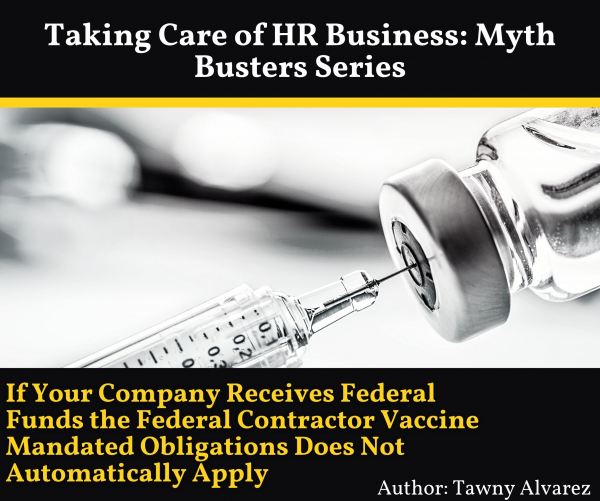Myth Buster: If Your Company Receives Federal Funds the Federal Contractor Vaccine Mandated Obligations Does Not Automatically Apply
 This is the second in a series of posts from Verrill with the purpose of helping to dispel myths that are currently circulating concerning employment laws and rules related to COVID-19.
This is the second in a series of posts from Verrill with the purpose of helping to dispel myths that are currently circulating concerning employment laws and rules related to COVID-19.
On September 24, the Safer Federal Workforce Task Force issued draft Guidance for Federal Contractors entitled COVID-19 Workplace Safety: Guidance for Federal Contractors and Subcontractors. A copy of the Guidance is available here. On September 30, 20201, the GSA Office of Governmentwide Policy issued CAAC 2021-03 Memorandum for Civilian Agencies with the Subject: Class Deviation from the Federal Acquisition Regulation Regarding Implementation of Executive Order 14042, Ensuring Adequate COVID Safety Protocols for Federal Contractors. A copy of that document is available here. These two documents provide the main sources of information concerning federal contractor obligations as they relate to the vaccine mandate.
One myth we are hearing repeated by several friends and clients is that because the entity receives federal funds, they are bound by the obligations that have been communicated by the Safer Federal Workforce Task Force. This is not true. Instead, the rule applies only to employers who enter into Contract and Contract-Like Instruments.
What is a Contract or Contract-Like Instrument? As of October 8, 2021 (because the definition in use was created July 22, 2021 and is subject to change once the Department of Labor (DOL) issues a final rule related to the increase of minimum wage for federal contractors), this phrase means:
An agreement between two or more parties creating obligations that are enforceable or otherwise recognizable at law. This definition includes, but is not limited to, a mutually binding legal relationship obligating one party to furnish services (including construction) and another party to pay for them. The proposed definition of the term contract broadly includes all contracts and any subcontracts of any tier thereunder, whether negotiated or advertised, including any procurement actions, lease agreements, cooperative agreements, provider agreements, intergovernmental service agreements, service agreements, licenses, permits, or any other type of agreement, regardless of nomenclature, type, or particular form, and whether entered into verbally or in writing.
86 Fed. Reg. 38,816, 38,887 (July 22, 2021). The Safer Federal Workforce Task Force, however, notes the following with the definition:
This definition includes, but is not limited to, a mutually binding legal relationship obligating one party to furnish services (including construction) and another party to pay for them. The term contract includes all contracts and any subcontracts of any tier thereunder, whether negotiated or advertised, including any procurement actions, lease agreements, cooperative agreements, provider agreements, intergovernmental service agreements, service agreements, licenses, permits, or any other type of agreement, regardless of nomenclature, type, or particular form, and whether entered into verbally or in writing. The term contract shall be interpreted broadly as to include, but not be limited to, any contract within the definition provided in the FAR at 48 CFR chapter 1 or applicable Federal statutes. This definition includes, but is not limited to, any contract that may be covered under any Federal procurement statute. Contracts may be the result of competitive bidding or awarded to a single source under applicable authority to do so. In addition to bilateral instruments, contracts include, but are not limited to, awards and notices of awards; job orders or task letters issued under basic ordering agreements; letter contracts; orders, such as purchase orders, under which the contract becomes effective by written acceptance or performance; exercised contract options; and bilateral contract modifications. The term contract includes contracts covered by the Service Contract Act, contracts covered by the Davis-Bacon Act, concessions contracts not otherwise subject to the Service Contract Act, and contracts in connection with Federal property or land and related to offering services for Federal employees, their dependents, or the general public.
Definition of Contract and Contract-Like Instrument, COVID-19 Workplace Safety: Guidance for Federal Contractors and Subcontractors (available at: https://www.saferfederalworkforce.gov/downloads/Draft%20contractor%20guidance%20doc_20210922.pdf) (last accessed October 8, 2021).
Does This Include Entities That Receive Medicaid or Clean Water State Revolving Fund (CWSRF) Funds? Not currently, but other obligations may be applicable under forthcoming CMS mandates. The Department of Labor has indicated that federal grants under Medicaid or under the CWSRF and contracts entered into by state or local governments to administer Medicaid or CWSRF programs are outside the scope of the definition of contract or contract-like instrument.
Does This Include Contracts Under the Walsh-Healey Public Contracts Act? Maybe. I know that’s not an ideal answer. The Department of Labor has noted that “contracts for the manufacturing or furnishing of materials, supplies, articles, or equipment to the Federal Government [subject to the Walsh-Healey Public Contracts Act], are not covered” by President Obama’s Executive Order 13658, which provides the definition of contract or contract-like instrument for purposes of current EO 14042.
In the text of EO 14042 (related to COVID-19 mandates), it notes that the order shall not apply to:
(i) grants;
(ii) contracts, contract-like instruments, or agreements with Indian Tribes under the Indian Self-Determination and Education Assistance Act (Public Law 93-638), as amended;
(iii) contracts or subcontracts whose value is equal to or less than the simplified acquisition threshold, as that term is defined in section 2.101 of the Federal Acquisition Regulation;
(iv) employees who perform work outside the United States or its outlying areas, as those terms are defined in section 2.101 of the Federal Acquisition Regulation; or
(v) subcontracts solely for the provision of products.
Executive Order 14042(5)(b). Okay, so two reliable sources appear to indicate that subcontracts solely for the provision of products are excluded. But in the definition section of COVID-19 Workplace Safety: Guidance for Federal Contractors and Subcontractors, the Safer Federal Workforce Task Force extends the definition by noting “This definition includes, but is not limited to, any contract that may be covered under any Federal procurement statute.” In the Guidance provided by the SFWTF, the following language is included: “Consistent with applicable law, agencies are strongly encouraged to incorporate a clause requiring compliance with this Guidance into contracts that are not covered or directly addressed by the order because the contract is under the Simplified Acquisition Threshold as defined in Section 2.101 of the FAR or is a contract or subcontract for the manufacturing of products.” As a result, each agency will have the ability to determine whether this clause is included in the contract for the manufacturing of products.
This information is current as of October 8, 2021. For more information, please contact Tawny Alvarez or another member of Verrill’s Employment and Labor Practice Group.










